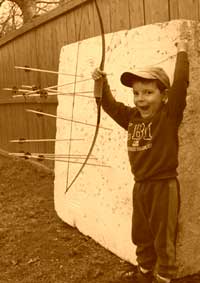| From: RC
|
|
|
|
|
|
|
| Date: 18-Mar-19 |
|
Yup, always been that way.
|
|
| From: GF
|
|
|
|
|
|
|
| Date: 18-Mar-19 |
|
Just to be clear… It doesn’t actually stiffen the arrow, of course, but because there is more load on the string, the rate of acceleration is reduced… And the arrow flexes less under the diminished force.
Which is why Learned Folk counsel us to tune our bare shafts to show slightly weak...
|
|
| From: camodave
|
|
|
|
|
|
|
| Date: 18-Mar-19 |
|
I always try to achieve a slightly weak bareshaft condition. Or use french curve fletch like Howard Hill did. One only has to get close.
DDave
|
|
| From: SB
|
|
|
|
|
|
|
| Date: 18-Mar-19 |
|
Yep ..old news
|
|
| From: Rick Barbee
|
|
|
|
|
|
|
| Date: 18-Mar-19 |
|
[[[ "Just to be clear… It doesn’t actually stiffen the arrow, of course, but because there is more load on the string, the rate of acceleration is reduced… And the arrow flexes less under the diminished force.
Which is why Learned Folk counsel us to tune our bare shafts to show slightly weak..." ]]]
^^^THIS^^^
Side Note: I wish Marco made "French Curve" soft vanes. 8^)
Rick
|
|
| From: Bender
|
|
|
|
|
|
|
| Date: 19-Mar-19 |
|
Actually rather than trying to figure out what "slightly weak" might actually look like when examining the points of impact on the target, I wrap the nock end of the bare shaft with some duct tape that weighs the same as the fletching being used on the fletched shafts.
That way you can just shoot and interpret your tuning results "as is" without having to wonder about it.
|
|
| From: Krag
|
|
|
|
|
|
|
| Date: 19-Mar-19 |
|
I believe adding weight to the back of the arrow which changes the mass distribution of the arrow has more affect on dynamic spine than adding the same weight to the string to reduce string velocity same as changing point weight does.
"Conversely, a larger mass at the tail of the arrow creates a tendency for the tail to resist the initial change in motion from the force applied to the bowstring, causing the shaft to deform less, with the same effect as increasing the stiffness of the shaft. Reducing the tail mass would have the opposite effect."
The Mechanics of Arrow Flight upon Release Lieu, D.K. University of California, Berkeley
|
|
| From: timex
|
|
|
|
|
|
|
| Date: 19-Mar-19 |
|
y'all boys sure do make shooting the simple stick & string seam awfully complicated
|
|
| From: Krag
|
|
|
|
|
|
|
| Date: 19-Mar-19 |
|
And it gets better...LOL
"The natural frequencies are inversely proportional to length, proportional to the square of the outer radius, proportional to the square root of the elastic modulus, and inversely proportional to the square root of mass per unit length. All the relationships need to be considered when designing or modifying an arrow for the proper clearance frequency. In addition, when masses are placed at the tip and tail of the shaft, the natural frequencies will certainly be decreased as the added mass increases."
|
|
| From: Krag
|
|
|
|
|
|
|
| Date: 19-Mar-19 |
|
Sorry guys. That must have been the world class archer wannabe hidden somewhere in my subconscious that caused my TP acting out.
The statement about back of arrow weight and stiffness wasn't entirely accurate and this was the first source I came across. Since we don't normally weigh down the nock end when tuning the affect is miniscule compared to tip weight and that is a good thing.
|
|
If you have already registered, please sign in now
For new registrations Click Here
|
|
|
|




